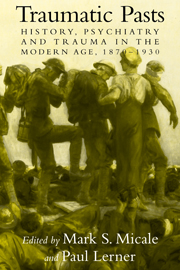Book contents
- Frontmatter
- Contents
- Contributors
- Preface
- 1 Trauma, Psychiatry, and History: A Conceptual and Historiographical Introduction
- Part One Travel and Trauma in the Victorian Era
- 2 The Railway Accident: Trains, Trauma, and Technological Crises in Nineteenth-Century Britain
- 3 Trains and Trauma in the American Gilded Age
- Part Two Work, Accidents, and Trauma in the Early Welfare State
- Part Three Theorizing Trauma: Psychiatry and Modernity at the Turn of the Century
- Part Four Shock, Trauma, and Psychiatry in the First World War
- Index
- Titles in the series
2 - The Railway Accident: Trains, Trauma, and Technological Crises in Nineteenth-Century Britain
Published online by Cambridge University Press: 14 October 2009
- Frontmatter
- Contents
- Contributors
- Preface
- 1 Trauma, Psychiatry, and History: A Conceptual and Historiographical Introduction
- Part One Travel and Trauma in the Victorian Era
- 2 The Railway Accident: Trains, Trauma, and Technological Crises in Nineteenth-Century Britain
- 3 Trains and Trauma in the American Gilded Age
- Part Two Work, Accidents, and Trauma in the Early Welfare State
- Part Three Theorizing Trauma: Psychiatry and Modernity at the Turn of the Century
- Part Four Shock, Trauma, and Psychiatry in the First World War
- Index
- Titles in the series
Summary
When H. G. Wells suggested in 1901 that “The nineteenth century, when it takes its place with the other centuries in the chronological charts of the future, will, if it needs a symbol, almost certainly have as that symbol a steam engine running upon a railway,” his comment reflected not only the economic, social, and industrial importance of the railway in the nineteenth century, but also its significance as an expression of a characteristic Victorian ideology in which engineering achievement was identified with economic expansion and social progress. However, from the point of view of the modern historian – and particularly the historian of trauma – as a symbol of the nineteenth century a steam engine running off a railway and dragging its train to destruction behind it might serve equally well. The railway accident was as much a product of the industrial nineteenth century as the modern, sophisticated, steam-powered railway itself, and it embodies and symbolizes many of the age's apprehensions about progress, technological development, and modernity as surely as the speeding express, the soaring viaduct, and the bustling station express its positive belief in such concepts. Just as the Victorian railway was a vast, dramatic, and highly visible expression of technology triumphant, so the railway accident constituted a uniquely sensational and public demonstration of the price which that triumph demanded – violence, destruction, terror, and trauma.
- Type
- Chapter
- Information
- Traumatic PastsHistory, Psychiatry, and Trauma in the Modern Age, 1870–1930, pp. 31 - 56Publisher: Cambridge University PressPrint publication year: 2001
- 16
- Cited by



